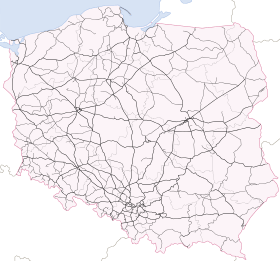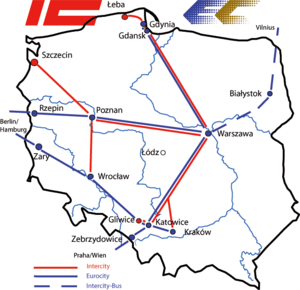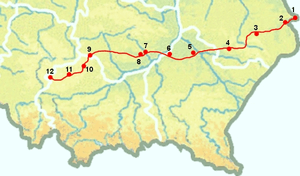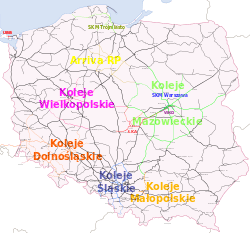Rail transport in Poland
 Railway network in 2014 | |
 Pendolino train in Kraków | |
| Dates of operation | 22 May 1842–present |
|---|---|
| Track gauge | 1,435 mm (4 ft 8 1⁄2 in) standard gauge |
| Electrification | 3 kV DC Overhead line |
| Length | 19,599 km (12,178.3 mi) |



The Polish railways network consists of around 19,599 kilometres (12,178 mi) of track as of 2008, of which the vast majority is electrified at 3 kV DC overhead.
Poland is a member of the International Union of Railways (UIC): its UIC Country Code is 51.
Rail services are operated by a range of public and private rail operators. The nationally owned PKP Group operates the majority of rail services. In addition to PKP owned companies, there are a number of private cargo operators, as well as a number of independent passenger operators, owned predominantly by Voivodeship governments.
Overview
The network is generally electrified, and the vast majority was built before World War II by different rail companies when territory was part of other countries, including the Deutsche Reichsbahn and Russian Imperial State Railways or by the Communist authorities from 1946 onwards. Due to the average age of the network and lack of maintenance, many sections are limited to speeds below 160 km/h (99 mph) even on trunk lines. 2,568 km (1,596 mi) allow 160 km/h (99 mph) or more.[1]
Since Poland's entry into the European Union in 2004, major financing has been made available by European financing institutions to improve both the Polish rail network and the rolling stock fleet. Up to June 2014, the European Investment Bank had provided loans totaling €1.9 billion for rail modernization projects in Poland.[2][3] An additional €578 million had been provided through December 2013 to modernize 70 percent of PKP Intercity rolling stock.[4] The €665 million purchase of twenty Alstom Pendolino high speed trains delivered in 2014 was financed in part by €342 million from the European Investment Bank.[5]
Poland currently has no high-speed lines operated at speeds above 200 km/h (124 mph). The Central Rail Line, centralna magistrala kolejowa, 'CMK', which links Warsaw to Katowice and Kraków, was designed with an alignment to permit 250 km/h (155 mph), but for over 30 years after its construction Poland possessed no rolling stock capable of speeds above 160 km/h (99 mph). Since 2008 the CMK has been upgraded to allow higher speeds, including installation of European Train Control System Level 1 which provides the Cab signalling required by high speed trains. Most trains on the CMK still operate at speeds up to 160 km/h (99 mph), but since 14 December 2014 new Alstom Pendolino ED250 trains operate on a 90 km section of the CMK at 200 km/h (124 mph), and improvements under way should raise the authorized speed to 200 km/h (124 mph) on most of the line. In test runs on the CMK in November 2013 a new Pendolino ED250 train set a new Polish speed record of 293 km/h (182 mph).[6]
In 2011-2015 the Warsaw-Gdańsk-Gdynia railway route has undergone a major upgrading costing $3 billion, partly funded by the European Investment Bank, including track replacement, realignment of curves and relocation of sections of track to allow speeds up to 200 km/h (124 mph), modernization of stations, and installation of the most modern ETCS Level 2 signalling system, which is to be completed in June 2015. In December 2014 new Alstom Pendolino high-speed trains were put into service between Gdańsk, Warsaw and Kraków reducing the rail travel time from Gdańsk to Warsaw to 2 hours 58 minutes,[7][8] to be reduced in late 2015 to 2 hours 37 minutes.[9]
In 2008, the government announced the construction of a dedicated high speed line based on the French TGV model and possibly using TGV style trainsets, by 2020. The Y-shaped line would link Warsaw to Łódź, Poznań and Wrocław at speeds of up to 320 km/h (199 mph)}. The plans included an upgrade of the Central Rail Line to 250 km/h (155 mph) or more, as this line has an LGV-like profile. In December 2011 plans to build the high speed 'Y' line were postponed until 2030, due to the high cost.[10][11]
As of 2008, foreign services include EuroCity and EuroNight trains between Western and Eastern Europe, most notably the EN Jan Kiepura direct sleeping cars between Russia and Amsterdam, Basel and Munich via Warsaw, Poznan and Germany. They generally consist of coaches from different rail operators that are added to the train as it passes through their area of operation.
Links with adjacent countries
Voltage of electrification systems may differ.
- Same gauge:
- Czech Republic – same voltage
- Germany – 3 kV DC/15 kV AC
- Slovakia – same voltage
- Sweden – by train ferry, 3 kV DC/15 kV AC
- Break-of-gauge – 1,435 mm (4 ft 8 1⁄2 in)/1,520 mm (4 ft 11 27⁄32 in)
- Belarus – 3 kV DC/25 kV AC, a short stretch of dual-gauge track terminates at Grodno
- Lithuania – 3 kV DC/25 kV AC, a short stretch of non-electrified dual-gauge track terminates at Šeštokai, as part of the construction of Rail Baltica a new standard-gauge line from there to Kaunas was built
- Russia (Kaliningrad Oblast) – not electrified – there are short stretches of dual gauge sections around border area
- Ukraine – 3 kV DC/25 kV AC
Broad-gauge railways

The network is standard gauge except for the Broad Gauge Metallurgy Line (known by its Polish abbreviation LHS) and a few short stretches near border crossings. The LHS to Sławków is the longest line, single track for almost 400 km from the Ukrainian border just east of Hrubieszów. It is the westernmost broad gauge line connected to the system of the former Soviet Union.
Narrow gauge railways
Operators
PKP Group
Polskie Koleje Państwowe (PKP), a state-owned corporate group, is the main provider of railway services, holding an almost complete monopoly on long-distance passenger services. It is both supported and partly funded by the government.
- There are three main PKP companies:
- PKP PLK - owns and maintains infrastructure including lines and stations.
- PKP Intercity - provides long-distance connections on the most popular routes. Trains are divided into the categories: EuroNight (EN), EuroCity (EC), Express InterCity (EIC), Express InterCity Premium (EIP)- generally faster and more expensive, InterCity (IC) and (TLK) (interregional fast trains, slower than EN/EC/EIC but cheaper) and international fast trains.
- PKP Cargo provides cargo rail transport.
- Przewozy Regionalne formerly PKP Przewozy Regionalne, is a train operator in Poland, responsible for local and interregional passenger transportation. Each day it runs approximately 3,000 regional trains. During 2002 it carried 215 million passengers. Przewozy Regionalne is a company owned by the various Voivodeship governments, each owning various share portions.
Regional trains, categories: Regio, InterRegio, RegioExpress, InterRegioBus.
Non-PKP Operators

While PKP is the largest rail operator in Poland, there are several independent operators of passenger and cargo railway services. Independent Cargo operators are predominantly privately owned. Passenger operators are predominantly owned by Voivodeship governments. These include:
- Przewozy Regionalne - owned by regional authorities of the 16 voivodeships, formerly part of PKP Group. Operates local passenger trains (under the REGIO brand) financed by local governments, low-cost long-distance trains (interREGIO) and short-distance international trains jointly with DB Regio (REGIOekspres). Passenger trains are rather slow, mostly electric multiple units and diesel railcars/railbuses. InterREGIO trains are of slightly lower standard than TLK trains (no first class and dining cars), but are usually a bit cheaper.
- Deutsche Bahn
- DB Regio connects from the border stations at Gorzów, Kostrzyn, Szczecin with the DB network with local trains (the Polish parts of their routes are generally operated by Przewozy Regionalne).
- Arriva RP (a wholly owned subsidiary of Deutsche Bahn) is a regional operator on lines in the Kuyavian-Pomeranian and Pomeranian regions
- Koleje Dolnośląskie a regional operator on a few lines in Lower Silesia.
- Koleje Mazowieckie a regional operator on all lines in Masovian Voivodeship, including Warsaw.
- Koleje Małopolskie a regional operator Cracow
- Koleje Wielkopolskie a regional operator on a few lines in Greater Poland Voivodeship.
- Koleje Śląskie a regional operator in the Silesian Voivodeship
- Łódzka Kolej Aglomeracyjna is a commuter railway operator in the Łódź Voivodeship.
- SKPL is a micro-operator providing services on branch lines and narrow-gauge lines.
Rapid transit
This includes:
- PKP Szybka Kolej Miejska in the Tri-city area of northern Poland
- Warszawska Kolej Dojazdowa, a suburban railway in Warsaw
- Szybka Kolej Miejska, a suburban city-owned line in Warsaw
- Warsaw Metro, an underground metro system in Warsaw, currently undergoing a period of expansion.
Freight Operators
Freight services are provided by a number of private and public rail operators. These include:
- Freightliner Group Limited
- DB Schenker Rail Polska
- PKP Cargo
- PKP LHS
- Lotos Kolej
- Orlen KolTrans
- CTL Logistics
See also
References
- ↑ PKP PLK, 'Raport roczny 2014', http://www.plk-sa.pl/files/public/raport_roczny/Raport_Roczny_2014_-26.01.2016.pdf (s. 38)
- ↑ 'EIB supports modernisation of Polish railways with EUR 268m loan,' http://europa.eu/rapid/press-release_BEI-14-122_en.htm
- ↑ 'EIB supports increase in Polish train speeds,' Railway Gazette International 25 October 2012, http://www.railwaygazette.com/news/infrastructure/single-view/view/eib-supports-increase-in-polish-train-speeds.html
- ↑ 'EIB supports upgrade of Polish railways with EUR 186m loan,' http://europa.eu/rapid/press-release_BEI-13-249_en.htm
- ↑ 'EIB increases Polish Pendolino loan,' Railway Gazette International, 15 May 2013 http://www.railwaygazette.com/news/passenger/single-view/view/eib-increases-polish-pendolino-loan.html
- ↑ 'Bariera 300 km/h nie padła. Na koniec testów 293 km/h,' Rynek Kolejowy, 2013 11 24, http://www.rynek-kolejowy.pl/49466/bariera_300_km_h_nie_padla_na_koniec_testow_293_km_h.htm
- ↑ 'Polish Pendolino launches 200 km/h operation,' Railway Gazette International, 15 December 2014, http://www.railwaygazette.com/news/passenger/single-view/view/polish-pendolino-launches-200-kmh-operation.html
- ↑ 'Pendolino z Trójmiasta do Warszawy,' http://www.trojmiasto.pl/wiadomosci/Pendolino-z-Trojmiasta-do-Warszawy-Wiecej-pytan-niz-odpowiedzi-n71010.html
- ↑ ';Jeszcze szybciej z Warszawy do Gdańska,' Kurier Kolejowy 9 01 2015 http://www.kurierkolejowy.eu/aktualnosci/22716/Jeszcze-szybciej-z-Warszawy-do-Gdanska.html
- ↑ 'Polish high speed rail project cancelled,' Railway Gazette International, 8 December 2011, http://www.railwaygazette.com/news/infrastructure/single-view/view/polish-high-speed-rail-project-cancelled.html
- ↑ http://wyborcza.biz/biznes/1,101562,10779265,Rzad_odklada_szybka_kolej_na_polke.html
External links
- National railways operator company official website
- Rail Passenger Portal with detailed timetable search engine
- Current train schedule
- Information on the periodic difficulties in the movement of trains in Poland
- Information about current delays trains
- Polish Rail TV
- Rail carrier PKP Intercity
- Rail carrier Przewozy Regionalne
| Wikimedia Commons has media related to Rail transport in Poland. |